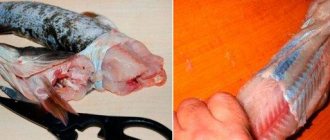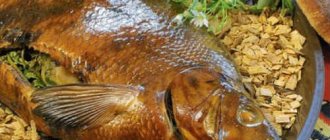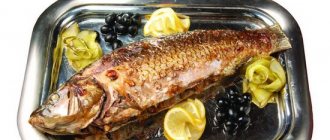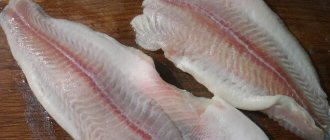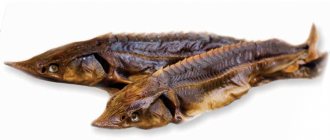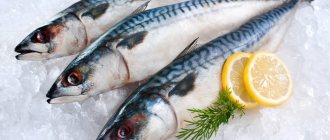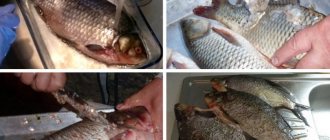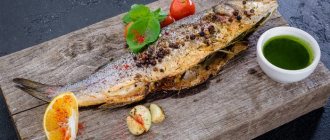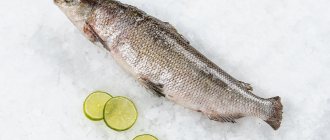Benefits of boneless fish
Why should housewives still be interested in fish species that do not have a mesh of bones? Because the processes of its preparation and consumption have many advantages. First of all, they consist in the fact that when eating it, a gourmet will not encounter the problem of small seeds getting into the mouth, which can have far from the most favorable consequences.
As for the advantages of the process of cutting fish of this type, they boil down to the fact that during cleaning of this product, as a rule, only the ridge, which, as a rule, is presented in the form of cartilage, has to be removed.
Another advantage of boneless fish is that during its heat treatment, the remaining cartilage softens so much that when eating the finished fillet, you simply cannot feel it. Many young parents note that boneless fish can be used to prepare very healthy children's dishes - in the process of consuming such food, tiny and very soft cartilages cannot harm the child's health.
Boneless fish cooks quite quickly: as a rule, it takes about 10-15 minutes. As for the marine and oceanic types of this product, they are ideal for making soups - the fillet gives an amazing aroma, which is distinguished by its unique aroma and richness.
Preparing the fish
Smaller fish, such as smelt or capelin, require less preparation. It is allowed to fry it without gutting, although this gives a specific taste, especially to capelin. If possible, it is better to get rid of the insides. No need to marinate, just add salt and pepper.

Cutting fish before frying
Fish with small scales, such as river trout or char, do not need to be scaled; just remove the insides and rinse with water. Marinate as desired, depending on the recipe, but you can get by with salt and pepper.
Large species must be cleaned of scales and entrails, thoroughly washed and cut into steaks or fillets. In some cases, they marinate in advance to make the flesh a little firmer, making it easier to fry.

Fish does not require long-term marinating, but it is not prohibited. The main thing is that the marinade is not aggressive.
Japanese chef Nobu marinates his signature cod for 24 hours in a mixture of spices, soy sauce and mirin, the result surprises many.
List of fish species without bones
Unfortunately, today only a small part of housewives know what kind of boneless fish is sold on store shelves. Let us further consider the list of the main types of such river and sea products, dividing them into families.
The sturgeon family is one of the most valuable in the culinary field. This is due not only to the fact that black caviar is obtained from fish of this species. Sturgeon are incredibly valued also because representatives of this family have amazing taste. Boneless fish from the sturgeon group include the following: sterlet, kaluga, beluga, stellate sturgeon, thorn, burbot, eel, catfish, carp and pike perch.
Speaking about the salmon family, we can also highlight a whole list of boneless fish. These include: taimen, trout, whitefish, salmon, and chum salmon. If you look closely at this list, you will notice that it contains those types of fish that have a bony spine, but in fact it is the only solid particle in the structure of the individual - by removing it, you can please yourself with a completely boneless fillet of healthy fish.
Having examined the most valuable breeds of fish, you can turn your attention to which fish without bones live in the depths of the sea. These include the following: sea bass, haddock, mackerel, icefish, womer, yellowtail, conger eel, tuna, hake, mackerel, horse mackerel, as well as navaga and sole.
Fans of fish dishes pay special attention to those types of sea and river products that do not have scales, since their manual processing takes much less time. Fish without bones or scales include: mackerel, conger eel, catfish, sturgeon, burbot and river eel.
Boneless fish
If you make a rating of fish without bones, then the list will be topped by all types of sturgeon and salmon. These species belong to both sea and river species; there are anadromous species, that is, those that live in salt water and spawn in fresh water. The river eel is also a boneless fish; on the contrary, it goes into sea water to spawn.
Sturgeons have a skeleton consisting of cartilage and a bony chord; they do not have small bones in the pulp. Both sturgeon meat and their black caviar have nutritional value, but poaching has led to a sharp decline in the population of all species of this family, so some sturgeon are included in the Red Book by the international environmental community. Names of sturgeon: beluga, kaluga, stellate sturgeon, sterlet, Russian sturgeon, thorn.
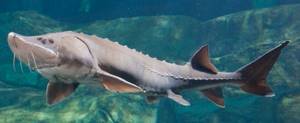
Salmon are large representatives of the ichthyofauna. Although migratory species belong to the class of bony fish (they have little cartilage), their bones are large and difficult to choke on, and they are also easily separated from the fillet when cutting. Red meat and caviar of chum salmon, pink salmon, salmon, trout, and taimen have the greatest nutritional value.
Marine
Fish that live in salty sea waters are considered less bony than freshwater species, because. she does not have a large number of small fork bones. But still, of the wide variety of sea fish without bones, the list of the most in demand is headed by representatives of the families:
- mackerel (tuna, mackerel);
- horse mackerel (horse mackerel);
- cod (hake, grenadier, navaga, haddock, pollock, blue whiting, cod).
Small-boned fish also include inhabitants of the deep sea - bottom-dwelling fish, halibut, flounder, and sole. The sea mullet, which lives in warm waters off the Australian coast, does not have small bones, its skeleton consists of plates. The delicacy eel has a flexible and soft body; it has many vertebrae, but no ribs or small bones.
River
Small and medium-sized freshwater representatives of the ichthyofauna have a complex skeletal structure and, accordingly, many bones. Among the large inhabitants of rivers (not counting migratory ones), lakes and other bodies of water, there are still species that can be classified as boneless, these are:
- burbot;
- carp;
- catfish;
- zander.
River lampreys and eels also have a minimum number of small bones, and they also have no scales, which makes processing easier. Scaleless fish also include burbot and catfish.
How to defrost boneless fish
Having figured out what kind of boneless fish lives in the sea, as well as in other types of reservoirs, it should be noted that some of its species have certain requirements for defrosting the product. Let us next consider some of the features of this process of each of them.
As practice shows, inexperienced housewives very often have certain problems associated with thawing sturgeon and catfish. As a rule, all problems that arise are due to the fact that most novice cooks prefer to defrost the product in warm water. To achieve a positive result, this process must be carried out exclusively at room temperature and, preferably, in fresh air. The same rule applies to pre-cut fish fillets.
As for scaly and scaleless fish, they need to be defrosted in cold water, which must first be salted. Practice shows that this process, on average, takes about 5-6 hours.
As practice shows, some types of fish need to be cut frozen, so the process is much easier and faster. These include horse mackerel, mackerel, navaga and hake.
When planning the process of defrosting sea and river products, you should remember that the faster it happens, the tastier the cooked fish will be. Moreover, the juiciness of the finished product directly depends on the speed of this process.
Let us next consider some of the features of which boneless fish is especially well prepared in various ways.
River
The most common river fish for baking are pike perch, pike, carp
and
brook trout
. Depending on the dish, the fish is prepared differently, but it is best to marinate it in advance and cook it a little longer. Before baking, it is customary to fry tench by rolling it in flour, and it is better to bake river trout in foil with vegetables and herbs.
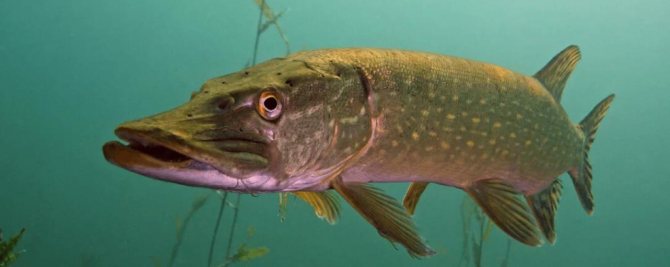
Pike fish
On average, river fish takes longer to bake than sea fish, so be careful about the preliminary preparation and temperature conditions. Sometimes, to protect against drying out, the fish is periodically watered with broth or a special sauce.
Ice fish
Ice fish meat belongs to the category of gourmet products. As practice shows, it can be used to prepare a lot of culinary masterpieces that will conquer even the most demanding gourmets. Ice fish can be cooked boiled, stewed or baked. What is the best boneless fish for frying? Of course, icy!
Both experienced and novice cooks need to know that this type of fish goes well with lemon balm, basil, and other spices. It should be noted that its taste is perfectly revealed when it goes through the marinating process before cooking. The ingredient is integral in the preparation of some salads and snacks. Some recipes suggest using it in the baking process - fish pie with it is especially tasty.
Ice fish is especially popular in Asian cuisine. Practice shows that in Japan it is consumed even raw, subject to special processing beforehand.
Fish without bones: truth or myth?
It's time to debunk the myth of completely boneless fish: there are no fish without bones in nature. This is physiologically impossible: every fish has at least a ridge or cartilage that holds the flesh and prevents the insides from falling apart. However, there are fish without small bones in the loin, which are anatomically built in such a way that large skeletal bones are enough for them to function normally.
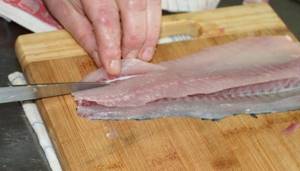
This kind of fish is easier to fillet and cut, it is safe for children (the risk of injury from the smallest bones is eliminated). Typically, sea fish (which is mainly used in the food industry) have fewer bones than river fish, but they are stronger. Popular wisdom also says that each of them has bones - for example, everyone knows the proverb “There is no fish without bones” or “You can’t eat a fish without bones.”
tilapia
When studying the list of boneless fish, you should definitely pay attention to tilapia - a product that, unfortunately, is quite rare on grocery store shelves and is a very valuable ingredient for various salads, appetizers, and casseroles.
Which boneless fish for a child will be the safest, tastiest and, most importantly, healthy? Of course, tilapia! This product contains a huge amount of Omega-3 and Omega-6 acids, which are vital for the development of any organism, including children.
How to properly cook this type of fish? According to professional chefs, it goes well with mushrooms, boiled eggs, pasta, rice, and potatoes. When cooking it, you should remember that it must be done in combination with fat-containing ingredients, since tilapia is a rather dry type of fish. When served, it goes well with creamy sauces, which highlight its taste very favorably.
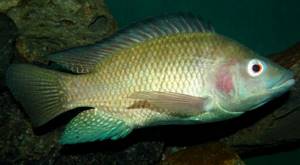
We eat without difficulty: fish with large bones
The fact that the listed types of fish do not have small bones makes them much easier to cut and cook. It is enough just to pull out a large ridge (which, as we found out, may not have full bone tissue), and the meat will be almost ready for further processing. Of course, fish with a developed bone network is also used in the food industry, however, such fish are mainly used for fish soup, fish cutlets, they are dried or dried, but you will rarely find raw fillets of bony fish on supermarket shelves.
We choose delicious sprats.
Sole
What is the best boneless fish for frying? Undoubtedly, this is the sole, which can be found without much difficulty on the shelves of specialized stores. In addition to frying, this product is excellent as a filling for baking pies, as well as for preparing delicious and very rich fish soup.
You should buy sole only fresh - this is the only way it will contain a lot of useful components and have a great taste. It must be defrosted carefully, only in salted water, otherwise the fillet fibers begin to break apart, which is why the fish simply disintegrates during the cooking process.
The process of frying the sole must be done in a very well-heated frying pan; this is the only way it will be able to obtain a very appetizing golden crust.
In the process of preparing this product, it is necessary to use a minimum amount of spices and herbs, as they tend to interrupt the delicate and unique taste of the seafood.
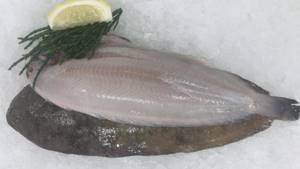
Vomer
Vomer fish is quite rare on the shelves of Russian stores. As practice shows, dishes made from it can only be found in the best restaurants in the country, and you can also cook it yourself at home.
Which boneless fish is best for baking? As practice shows, this is precisely vomer, but for this purpose it is best to use large types, since small ones will certainly turn out dry. This type of seafood is also excellent when grilled and stewed with vegetables. According to the comments of many gourmets, vomer is very tasty when smoked and dried.
This fish belongs to the dietary group; it contains a high level of protein, which is why it is valued.
Red
There are many types of red fish and they are easily confused with each other. The best red fish for frying is salmon
and
trout
.
Coho salmon, sockeye salmon
and
chinook salmon
occupy second place in the ranking.
Pink salmon
, depending on the quality, is also suitable for frying, but it is still better to bake it with vegetables or sauce.
The basic rule for all red fish is that they can be slightly undercooked, this will make them juicier, just be sure to buy the fish from reliable suppliers.
Horse mackerel
Horse mackerel is a fairly popular fish that can be very easily obtained on the shelves of Russian grocery stores. It is very valuable because it contains a lot of useful components, which include fats, vitamins C, A and B, as well as calcium, potassium, iodine, iron, manganese, magnesium, fluorine and zinc. Moreover, horse mackerel is one of the most important sources of Omega-3 acid, which is necessary for significant stabilization of the cardiovascular and nervous system of the human body.
As for the peculiarities of preparing this product, various chefs recommend preparing this product with the addition of various components. Thus, world culinary specialists notice that the taste of horse mackerel is revealed most favorably when spicy herbs (mostly dry), pickled onions, wine vinegar, rosemary, green olives and lemon are used in the cooking process. The preparation of mackerel is carried out everywhere by Japanese chefs, who first marinate it in rice vinegar with the addition of dry herbs and ginger, and then serve it without heat treatment.
What is the most delicious boneless fish? In many world rankings, the leading position is occupied by mackerel - a seafood product that in any form will have excellent taste. Cutlets and meatballs made from it have a particularly rich taste, and the product is excellent fried, boiled, baked (especially grilled), and smoked (both cold and hot processing are excellent). Canned mackerel also has a lot of fans.
When asked which boneless fish is best, many chefs answer that it is horse mackerel. This seafood is easy to cut: it consists only of lightly removing the backbone and then chopping it. It is recommended to cook it only at high temperatures - this is how the extraordinary taste and juiciness of the fish is preserved, for which it is very highly valued.
About obvious advantages
The undoubted advantage of a fish that does not have a developed bone network with tiny processes is that it is easier to cut and is relatively safe, as we have already mentioned. Of all the sea and river fish used in the food industry, those species that do not have small bones occupy a strong position, because the consumer does not want to spend a lot of time cutting up a bony product.
Find out which fish is the healthiest, how to choose fish, how to fry it, and whether fish oil is healthy.
Of course, this does not mean that bony types are less tasty; on the contrary, they make a richer broth, and they are superior in taste to some low-boned types. But only true lovers and connoisseurs of fish products are willing to spend a lot of time cleaning and cutting up, for example, roach and bream. Also, less bony species are safer to use as food - the possibility of swallowing small bones is eliminated.
Sea bass
What kind of fish (without bones) tastes good when fried? Most culinary specialists note that sea bass often occupies a leading position among these - a product that has long been classified as a delicacy. Fish is also excellently prepared in other ways: stewing, boiling, and baking. Its loin is distinguished by its juiciness, which is especially characteristic of the area located in the fin area. Moreover, sea bass has a lot of positive properties for the human body, which can instantly disappear if the product is not stored properly.
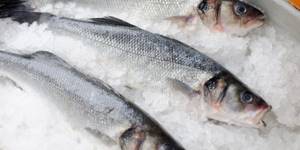
Sea bass is a fish that cannot be kept frozen for a long time - if it has been in ice for more than 8 hours, then the seafood fillet begins to lose its characteristic taste, becoming bland.
What sea fish without bones can perch be inferior in quality to? Yes, perhaps none. Sea bass is a product from which you can make excellent aspic, signature balyk, and also excellent soup. It is often used for baking. What kind of fish (without bones) should you fry so as to surprise even the most demanding gourmets? Of course, sea bass! When fried, this type of fish harmoniously combines with herbs, lemon, as well as spicy and creamy sauces.
Sea bass is especially prized in Japanese cuisine. Here they prepare rolls and sushi and some other dishes of national cuisine with it, and this individual has a slightly different name - sea bass. Moreover, this product is the main fish product in Indian cuisine - here they prepare nuggets, meatballs, cutlets, as well as traditional zarzuela.
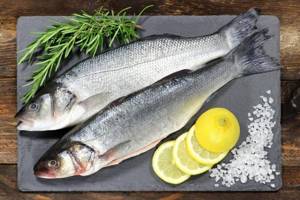
Som
Which boneless river fish is the most favorite among novice cooks? This is considered to be catfish - a fairly well-known commercial fish that can easily be found in specialized stores.
This river product contains a whole storehouse of useful components that are vital for maintaining the health of the human body, as well as its development. These include not only fats and proteins, but also a whole complex of vitamins (B, C, A, PP, E), as well as the amino acid lysine and rare trace elements (potassium, iron, cobalt, molybdenum, sodium, calcium, chlorine, manganese, copper, sulfur and zinc). In addition to all this, it has a high protein content, thanks to which it often serves as an excellent substitute for meat.
Catfish meat will also be very useful for those who are on a diet. Moreover, all this despite the fact that the product belongs to the fatty category. A particularly healthy dietary dish is steamed catfish.
What kind of boneless fish should a housewife cook who has set herself the goal of surprising all the invited guests? Of course, a catfish, and only its tail part. This product makes excellent fish soup, cutlets, main courses, as well as casseroles and pies. Smoked catfish has a very pleasant taste. Cooks often bake this river product in foil, with the addition of lemon or assorted vegetables.
In order to get rid of the river smell characteristic of catfish, you need to soak it in water mixed with lemon juice for about 2-3 hours.
Side dishes of boiled cereals are perfect for ready-made catfish, which is due to the presence in its composition of a large amount of lysine, which is very little in grains.
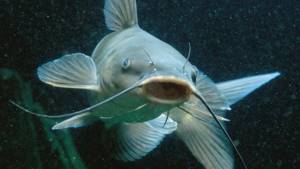
List of fish with few bones
River and sea fish with a small number of bones include:
№1 Eel
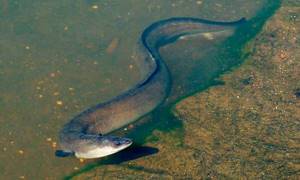
No. 2 River lamprey
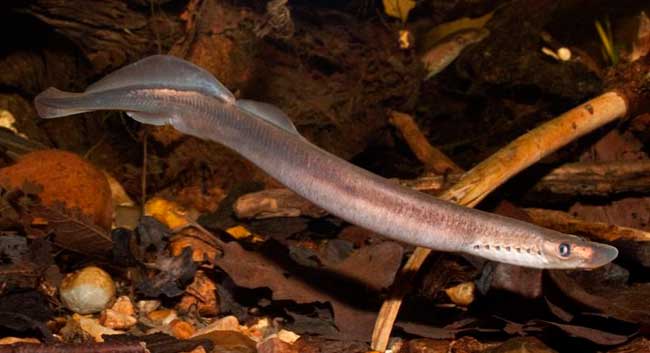
No. 3 Horse mackerel
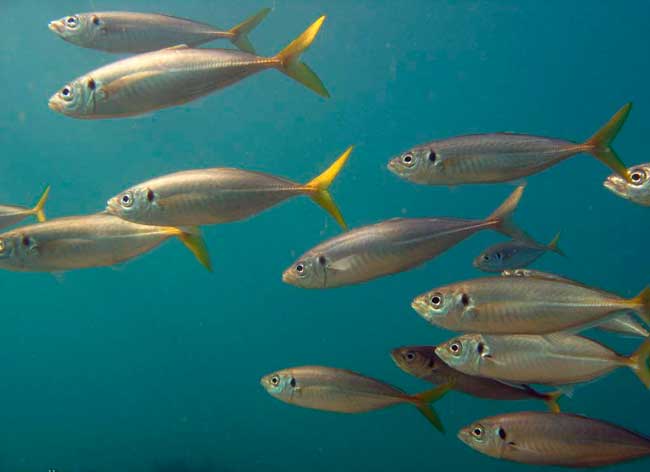
| Name | Description | Fat content per 100 g | Kcal per 100 g | Omega-3 in 100 gr. |
| Acne | Despite the fact that it lives in fresh water bodies, it swims to the Sargasso Sea to spawn. Eel meat is rich in vitamins A, B, C, E, PP, as well as potassium, calcium, magnesium, sulfur, phosphorus, etc. | 14% | 333 | 0,6 |
| river lamprey | Outwardly, an eerie fish, reminiscent of an overgrown leech, and just like it leads a parasitic lifestyle, clinging to underwater inhabitants and “pumping” nutrients from them. However, despite this, it is a rare delicacy that any fisherman dreams of catching. Lamprey meat is rich in vitamins and nutrients | 10% | 88 | 0,5 |
| Horse mackerel | One of the most “caught” fish in the seas and oceans. It is used in the manufacture of canned food, preserves, in pickles, etc. Horse mackerel meat contains vitamins B, E, C, A, as well as sodium, phosphorus, potassium, etc. | 7% | 130-190 | 1,48 |
Zander
Pike perch is an incredibly healthy fish for the human body that can be prepared in a variety of ways. It is considered a dietary product, as it contains virtually no fat. Its use is recommended for people who are prone to strokes and heart attacks, as well as those who have diabetes and suffer from swelling of the legs.
Pike perch meat is very tender and tasty, which is why it is highly valued in world cooking. When cooked, it is very easily absorbed by the body and is perfectly digested.
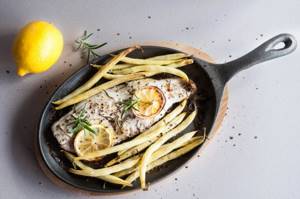
What kind of fish (without bones) is tasty and nutritious? Of course, this is the pike perch. This seafood product has amazing qualities that are perfectly revealed when fried, boiled, stewed and baked. During its preparation, it is recommended to use a large number of spices, as well as spices that only emphasize the presence of the product in the dish. Gourmets note that pike perch goes wonderfully with beer, white wine, and kvass. The ideal side dish for this fish is a vegetable bed made from asparagus, carrots, onions and potatoes. In addition to all this, pike perch tastes great with mushrooms, cheese, and creamy sauce.
